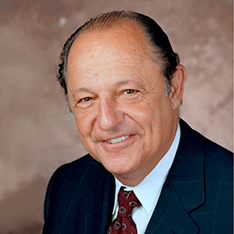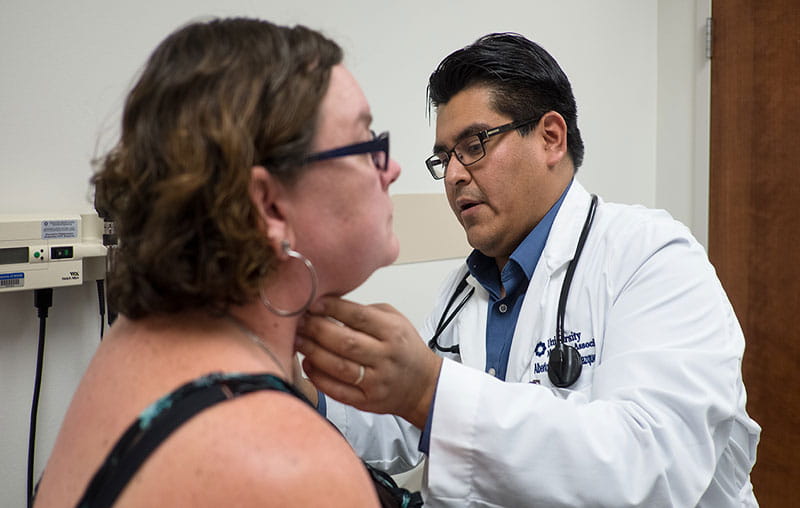Some of the world’s most popular Type 2 diabetes and weight loss medications are designed, tested and prescribed at University Health Texas Diabetes Institute.
“Some of the best research in the diabetes field in the last 25 years has come out of the Texas Diabetes Institute,” said Dr. Ralph DeFronzo, a world-renowned endocrinologist and deputy director of Texas Diabetes Institute.
Dr. DeFronzo is the brains behind semaglutide, the active ingredient in Hollywood’s favorite medication – Ozempic. Now, he’s lending his expertise to a new method of fighting Type 2 diabetes – surgical removal of visceral fat.
Mesenteric Visceral Lipectomy to Remove Belly Fat
Visceral fat (belly fat) has been linked to insulin resistance, a key part of Type 2 diabetes. A new minimally invasive procedure, mesenteric visceral lipectomy (MVL), dissolves and suctions out harmful belly fat. The MVL procedure showed promising results in clinical trial patients.
It works by removing the fat in the mesentery, the tissue attached to the intestines, without affecting the blood vessels. A patented medical device dissolves the glucose that holds the fat together, making it easier to suction out.
This procedure is still in its early stages and has not yet been fully approved by the Food and Drug Administration. It is only for people with a body mass index (BMI) between 30 and 40. Calculate your BMI with this tool.
To learn more about study eligibility, please call the Texas Diabetes Institute’s research line at 210-358-7200.
Metformin Development at Texas Diabetes Institute
While the research teams at Texas Diabetes Institute and UT Health San Antonio are pioneering new ways to treat or even reverse diabetes, DeFronzo has been leading the way in diabetes management research for the past 30 years.
In 1995, Dr. DeFronzo led the clinical trials of metformin at Texas Diabetes Institute. Metformin is a popular medication that controls blood sugar levels in people with Type 2 diabetes by shutting down the excess production of glucose by the liver.
It is often prescribed as a first-line therapy for Type 2 diabetes. “Metformin … represents about 45% of all first prescriptions written in the U.S., and it is the No. 1 drug used in Europe and throughout the world,” Dr. DeFronzo said.
Pioglitazone Improves Insulin Resistance
Pioglitazone is a drug that was developed at Texas Diabetes Institute and is now prescribed as a first-line therapy. “Pioglitazone is the only drug that truly improves insulin resistance, which is a hallmark of people with Type 2 diabetes,” Dr. DeFronzo said.
Dr. DeFronzo says pioglitazone may have the capability to treat other health conditions, too. He is studying its efficacy of treating a heart condition called heart failure with preserved ejection fraction.
SGLT-2 Inhibitors
Dr. DeFronzo also invented the SGLT-2 inhibitor class of drugs.
The kidneys of people with Type 2 diabetes have been programmed to hang on to glucose. SGLT-2 inhibitors allow the kidneys to get rid of glucose through urine. This helps treat Type 2 diabetes because when the blood sugar level comes down, insulin resistance improves, and the beta cells can better secrete insulin.
SGLT-2 inhibitors are also proven to slow the progression of diabetic kidney disease. “These drugs have turned out to protect your heart from heart failure and heart attacks. This class of drugs lowers your glucose, saves your kidneys and saves your heart,” Dr. DeFronzo said.
The Evolution of Exenatide to Ozempic
You've probably heard of Mounjaro and Ozempic. The original studies were done with a drug called exenatide, which was the first one of its kind approved by the FDA. Dr. DeFronzo led the clinical trials of exenatide and the generations of medications that came after.
Exenatide (also called Byetta) is a twice-daily injection that lowers glucose and promotes weight loss. There were several generations of this medication as research advanced, and today we have semaglutide, the active ingredient in Ozempic and Wegovy. The active ingredient in Mounjaro and Zepbound is tirzepatide.
Learn more about the difference between these medications and how they are used to manage Type 2 diabetes in our blog.
Triple Therapy Approach to Treating Type 2 Diabetes
Dr. DeFronzo believes in combining multiple medications to treat Type 2 diabetes, rather than prescribing one after another. Dr. DeFronzo prescribes metformin, pioglitazone and exenatide (brand name Bydureon) simultaneously from the start of a patient’s treatment journey.
The six-year EDICT study showed that this triple therapy approach helped 70% of participants get their A1C under 6.5%. The A1C test shows your average blood sugar levels over the past three months. An A1C of 6.5% or above indicates diabetes.
In contrast, the method of prescribing metformin, then sulfonylurea, then insulin leaves 71% of patients with an A1C of 6.5% or higher, meaning they are still considered diabetic.
“The reason our approach works is that the two big defects present in people with Type 2 diabetes are your beta cells don't work and you’re insulin resistant. We correct those defects,” Dr. DeFronzo said.
Revolutionary Diabetes Care at Texas Diabetes Institute
Much of the collaborative research that led to the development of these medications would not be possible without the Texas Diabetes Institute, which Dr. DeFronzo calls “a revolutionary concept.”
The three pillars of Texas Diabetes Institute are:
- Patient care
- Education
- Research
Patient Care at Texas Diabetes Institute
Patient care is the No. 1 priority at Texas Diabetes Institute, which is why it has everything a patient needs under one roof. Diabetes affects all other systems of the body, so we have specialists in a number of disciplines on-hand to consult with our patients.
When a patient comes to the institute, depending on their health goals, they may see multiple members of their care team in one visit, including:
- Doctor
- Nurse educator
- Ophthalmologist
- Cardiologist
- Nephrologist
- Podiatrist
- Exercise physiologist
- Dietitian
- Physical therapist
- Pharmacist
Diabetes Education and Fitness Center
Education is the second critical function of the institute. Patients can empower themselves to take charge of their own health by taking diabetes education classes.
Plus, the Fitness Center at Texas Diabetes Institute offers free fitness classes to patients with a provider’s referral. Patients work with a professional to take a personal fitness assessment and design a workout regimen that aligns with their lifestyle and goals.
“When you gain weight, you become resistant to insulin, and that makes your diabetes worse. So having a diabetes education program with emphasis on dietetics and having a gym with a physical therapist (is important),” Dr. DeFronzo said.
Diabetes Research
The final pillar of Texas Diabetes Institute is advancing diabetes research. Many of the leading therapies for treating Type 2 diabetes were discovered at Texas Diabetes Institute. Our researchers are on the leading edge of the next big breakthroughs in diabetes management. Learn more about our research goals and how to join a diabetes clinical trial.
Diabetes Care at University Health
Learn more about the world-class diabetes care at Texas Diabetes Institute in San Antonio.





